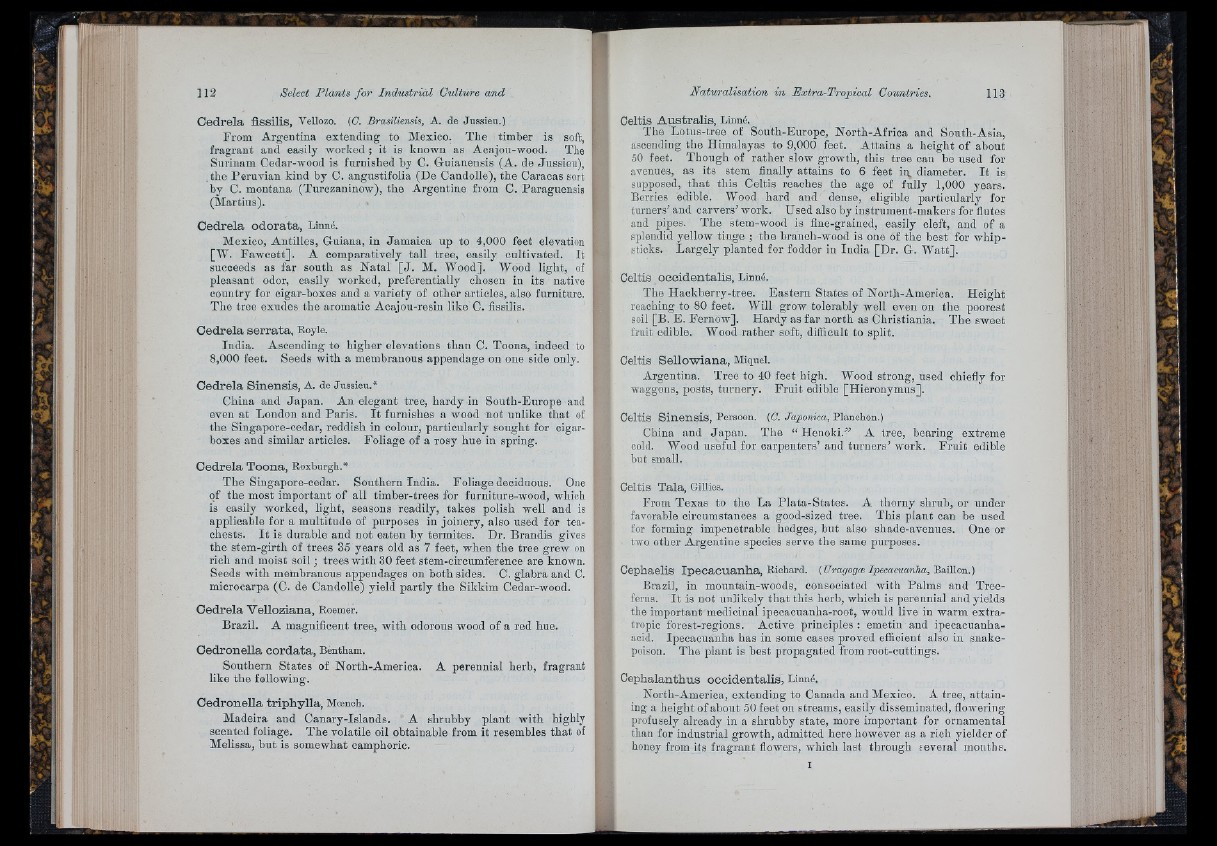
C e d r e la f is s ilis , Vellozo. (C. BrasiUensis, A. de Jussieu.)
From Argentina extending to Mexico. The timber is soft,
fragrant and easily worked ; it is known as Acajou-wood. The
Surinam Cedar-wood is furnished by C. Guianensis (A. de Jussieu),
.the Peruvian kind by C. angustifolia (De Candolle), the Caracas sort
by C. montana (Turczaninow), the Argentine from C. Paragiiensis
(Martins).
C e d r e la o d o r a ta , Linné.
Mexico, Antilles, Guiana, in Jamaica up to 4,000 feet elevation
[W. Fawcett], A comparatively tall tree, easily cultivated. It
succeeds as far south as Natal [ J . M. Wood]. Wood light, of
pleasant odor, easily worked, preferentially chosen in its native
country for cigar-boxes and a variety of other articles, also furniture.
The tree exudes the aromatic Acajou-resin like C. fissilis.
C e d r e l a s e r r a t a , Royle.
India. Ascending to higher elevations than C. Toona, indeed to
8,000 feet. Seeds with a membranous appendage on one side only.
C e d r e la S in e n s is , A. de Jussieu.*
China and Japan. An elegant tree, hardy in South-Europe and
even at London and Paris. I t furnishes a wood not unlike that of
the Singapore-cedar, reddish in colour, particularly sought for cigar-
boxes and similar articles. Foliage of a rosy hue in spring.
C e d r e la T o o n a , Roxburgh.*
The Singapore-cedar. Southern India. Foliage deciduous. One
of the most important of all timber-trees for furniture-wood, which
is easily worked, light, seasons readily, takes polish well and is
applicable for a multitude of purposes in joinery, also used for tea-
chests. I t is durable and not eaten by termites. Dr. Brandis gives
the stem-girth of trees 35 years old as 7 feet, when the tree grew on
rich and moist soil ; trees with 30 feet stem-circumference are known.
Seeds with membranous appendages on both sides. C. glabra and C.
microcarpa (C. de Candolle) yield partly the Sikkim Cedar-wood.
C e d r e la V e llo z ia n a , Roemer.
Brazil. A magnificent tree, with odorous wood of a red hue.
C e d ro n eU a o o r d a ta , Bentham.
Southern States of North-America.
like the following.
A perennial herb, fragrant
C e d ro n eU a t r ip h y l l a , Moench.
Madeira and Canary-Islands. A shrubby plant with highly
scented foliage. The volatile oil obtainable from it resembles th a t of
Melissa, but is somewhat camphoric.
C e ltis A u s tr a l is , Linné.
The Lotus-tree of South-Europe, North-Afriea and South-Asia,
ascending the Himalayas to 9,000 feet. Attains a height of about
50 feet. Though of rather slow growth, this tree can be used for
avenues, as its stem finally attains to 6 feet iq, diameter. I t is
supposed, th a t this Celtis reaches the age of fully 1,000 years.
Berries edible. Wood hard and dense, eligible particularly for
turners’ aud carvers’ work. Used also by instrument-makers for flutes
and pipes. The stem-wood is fine-grained, easily cleft, and of a
splendid yellow tinge ; the brauch-wood is one of the best for whip-
sticks. Largely planted for fodder in India [Dr. G. Watt].
Celtis o c c id e n ta lis , Linné.
The Hackberry-tree. Eastern States of North-America. Height
reaching to 80 feet. Will grow tolerably well even on the poorest
soil [B. E. Fernow]. Hardy as far north as Christiania. The sweet
fruit edible. Wood rather soft, difficult to split.
Celtis S e l lo w ia n a , Miquel.
Argentina. Tree to 40 feet high. Wood strong, used chiefly for
waggons, posts, turnery. Fruit edible [Hieronymus].
Osltis S in e n s is , Persoon. {G. Japónica, Planchón.)
China and Japan. The “ Henoki.” A tree, bearing extreme
cold. Wood useful for carpenters’ and turners’ work. Fruit edible
but small.
Celtis T a la , Gillies.
From Texas to the La Plata-States. A thorny shrub, or under
favorable circumstances a good-sized tree. This plant can be used
for forming impenetrable hedges, but also shade-avenues. One or
two other Argentine species serve the same purposes.
C ep h ae lis I p e c a c u a n i ia , Richard. ( Uragogce Ipecacuanha, Bâillon. )
Brazil, in mountain-woods, consociated with Palms and Tree-
ferns. I t is not unlikely th a t this herb, which is perennial and yields
the important medicinal ipecacuanha-root, would live in warm extra-
tropic forest-regions. Active principles : emetin and ipecacuanha-
acid. Ipecacuanha has in some cases proved efficient also in snake-
poison. The plant is best propagated from root-cuttings.
C ep h a lan th u s o c c id e n ta lis , Linné.
North-America, extending to Canada and Mexico. A tree, attaining
a height of about 50 feet on streams, easily disseminated, flowering
profusely already in a shrubby state, more important for ornamental
than for industrial growth, admitted here however as a rich yielder of
honey from its fragrant flowers, which last through feveral months.
'!■• Ii
!■
■
r-fr ■ ;■